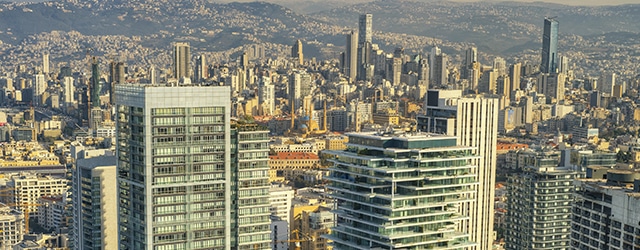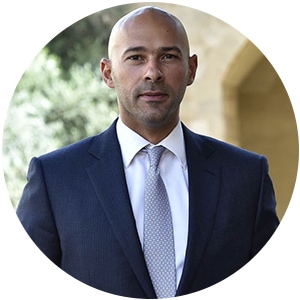The Lebanese economy was hit hard in recent years, mainly by spillover from Syria’s crisis. However, the financial sector has proven resilient and domestic political stability offers renewed prospects for growth.

Since 2011, the war in neighboring Syria has hit Lebanon hard. The country’s infrastructure and labor market is under pressure from the influx of refugees. According to Amnesty International, Lebanon hosts 1 million Syrian refugees, approximately a quarter of Lebanon’s total population. The conflict has also blocked Lebanon’s only overland trade route (the southern border with Israel having been closed since 2000) and driven Gulf tourists and investors away.
“All those things put together, the estimated cost of the Syrian crisis on Lebanon over the last five years exceeds $10 billion; it is a very important drain,” says Saad Azhari, chairman and general manager at BLOM Bank, the country’s second largest financial institution.
Without ever falling into recession, Lebanon went from 10% annual GDP growth in 2009 to a mere 1% to 2% GDP growth since 2014. Gross public debt increased significantly to reach 161% of GDP in 2016, the third highest debt-to-GDP ratio in the world, according to the CIA World Factbook.
With no hydrocarbon revenues and very little industry, and having suffered a civil war that lasted from 1975 to 1990, Lebanon’s postwar economy relies largely on tourism, foreign investment in real estate and remittances from its very large diaspora—more than 10 million Lebanese are estimated to live abroad, compared to just over six million in their home country.
With the Syrian crisis substantially affecting both tourism and real estate investment, the country now relies on foreign deposits as its main source of foreign currency, but that too is in decline.

FINANCIAL RE-ENGINEERING
Historically, foreign deposit inflows made up about 40% of Lebanese GDP. Those inflows are roughly composed of remittances from Lebanese expatriates, which make up 80%, and 20% is foreign direct investment (FDI), mostly from other Arab nationals.
According to the IMF’s Financial System Stability Assessment report published in January, Lebanon’s macroeconomic stability depends in large part on banks’ continued ability to attract foreign deposits. “With FDI having decreased in recent years, continued deposit inflows are the only significant source of capital inflows,” the report states. “The current slowdown in nonresident deposit growth led to declines in international reserves of just over 10% in the year up to May 2016,” the report adds, “the first drop in 11 years.”
“What we have witnessed since 2010 is a deceleration of inflows, which were insufficient to cover the trade deficit or to show a surplus in our balance of
payments,” says Freddie Baz, general manager and group strategy director at Bank Audi, Lebanon’s largest bank. “Coming from a high point of about $20 billion a year before the crisis, inflows decreased to about $12 billion. Although the drop was not enough to exert significant pressure on domestic liquidity or interest rates, we did feel the hit.”
The decline in customer deposits, combined with the decline in foreign currency reserves and a deficit in the balance of payments, pushed the Lebanese central bank, Banque du Liban (BDL), to initiate a significant financial engineering plan.
Starting in May 2016, BDL exchanged Lebanese pound-denominated treasury bills for $2 billion worth of eurobonds from the finance ministry. The eurobonds, along with other certificates of deposit in foreign currency, were then sold to the banks for an estimated
$13 billion. This operation allowed the central bank to boost foreign currency reserves to exceed $41 billion, compared to $35 billion in May. The balance of payments also reached an accumulated surplus of $1.3 billion.
To make the deal attractive for the banks, BDL offered to buy Lebanese pound treasury bills and certificates of deposit with maturities of 12 years or less at 0% discount, but with a haircut of 50%, which gave the banks large amounts of money upfront.
“The BDL has taken all the necessary precautionary measures to keep the financial sector sound and resilient,” says the governor of BDL, Riad Salamé. “The recent financial engineering scheme benefited the banking sector and the whole monetary situation. Customer deposits have increased by 7% in 2016, with additional funds of around $10 billion entering the banking sector.”
Although the BDL claims it had no other option to avoid increasing interest rates, the incentives given to the banks to follow the financial-engineering scheme stoked controversy in Lebanon and abroad.
“The BDL granted the banks a 30% up-front return, fully paid in Lebanese pounds, on the US-dollar instruments they were able to bring in,” says a senior analyst at a Lebanese bank who wishes to remain anonymous. “The entry ticket to benefit from that measure was high. Furthermore, the larger banks started distributing some of those returns to their richest clients to push them to transfer dollars. At the end of the day, the rich keep on getting richer; and the poor, due to inflation, become poorer.”
By the end of 2016, the consolidated balance sheet of all Lebanese banks amounted to $204.3 billion, an increase of 9.8% compared to 2015. Over the same period, total foreign currency deposits increased by 8.8% to reach $107 billion. In its latest report, the IMF calls on the Lebanese authorities to “rely on more direct interest rate tools and not expand the operation further.” The report urges the BDL to “gradually withdraw from quasi-fiscal economic stimulus measures.”

THE SWITZERLAND OF THE MIDDLE EAST
Banks are the backbone of the Lebanese economy. The services and banking sectors represent 70% of the country’s gross national product. Lebanese banks are the largest lenders to the public sector, holding 59% of Lebanon’s treasury bills and eurobonds.
Banks have formed the cornerstone of Lebanon’s economic strategy since the country’s independence in 1943. The laws promulgated in the 1950s on banking secrecy allowed Lebanon to attract large deposits from all over the region and forged its reputation as “the Switzerland of the Middle East.” Throughout the civil war and the many crises that followed, Lebanese banks have demonstrated spectacular resilience.
“We say that being Lebanese is not a citizenship, it’s a business line; and it seems that this line is banking,” explains Baz. “We have a long history of setbacks, but each time we were able to stand again. Experiences such as the civil war distinguish us from our regional peers, because we know how to manage uncertainties while being very conservative in terms of risk appetite. This is a clear competitive advantage. Going to countries like Iraq, Turkey, Algeria or Egypt feels almost normal to us.”
Lebanon may have lost part of its appeal to Gulf countries such as the UAE, which offers greater economic and political stability and better infrastructure. But to stay in the game, Lebanese financial institutions are banking on new technologies.
Last October, the central bank raised by $200 million its 2013 promise to guarantee $400 million in investment in the knowledge economy. According to central bank governor Salamé, in just three years, the Lebanese knowledge economy has attracted 800 start-ups, created 6,000 jobs, and increased national wealth by around $1 billion. He says the sector is expected to grow by around 7% to 9% per year for the next three years. “Equity financing has a high growth potential; and it is expected to grow exponentially when the BDL launches the dedicated stock market for small and mid-sized companies that will provide the necessary equity and liquidity for the said companies,” he explains. “This endeavor will expand the Lebanese capital markets and boost the Lebanese economy even further.”
Among many sectors of potential growth, fintech pioneers have attracted specific attention from investors. “We support projects with high growth potential; and within that scope, we privilege fintech innovation,” says Marwan Kheireddine, chairman at Al-Mawarid Bank, one of the few banks to carry out direct investments in start-ups.
Mobile banking is used marginally in Lebanon. According to a 2016 ArabNet report on digital banking adoption in the Middle East North Africa region, 75% of bank customers in Lebanon claim to visit their branches regularly. Although there is a growing appetite from the younger generations to use digital banking services, the country has to overcome structural challenges such as slow Internet, expensive mobile data subscriptions and daily electricity cuts.
NEW PROSPECTS FOR GROWTH
After enduring a two-year political vacuum, the election of a president of the republic last October and the formation of a government bring new hopes for the Lebanese economy. “We had reached a deadlock, and finally now there is a renewed sense of trust,” says Ali Awdeh, director of the research department at the Union of Arab Banks. “The economic indicators show that consumers have a positive outlook and feel confident.”
Confidence certainly came back, but that didn’t necessarily translate yet into more economic activity, says Talal Salman, economic adviser to the minister of Finance. “There is a little more consumption,” says Salman, “but to see a real impact we need to see a change in the Syrian crisis. When the time comes for reconstruction, the Lebanese banks, among other economic actors, will definitely play a big role.
“Another major growth driver over the medium term will be the oil and gas sector once exploration begins towards the end of 2017,” says Salman.
Due to a lack of political consensus, Lebanon’s offshore gas and oil resources have never been exploited; but since January, the new government has made such development a priority. Could Lebanon’s economic fortunes be about to begin a whole new chapter?



